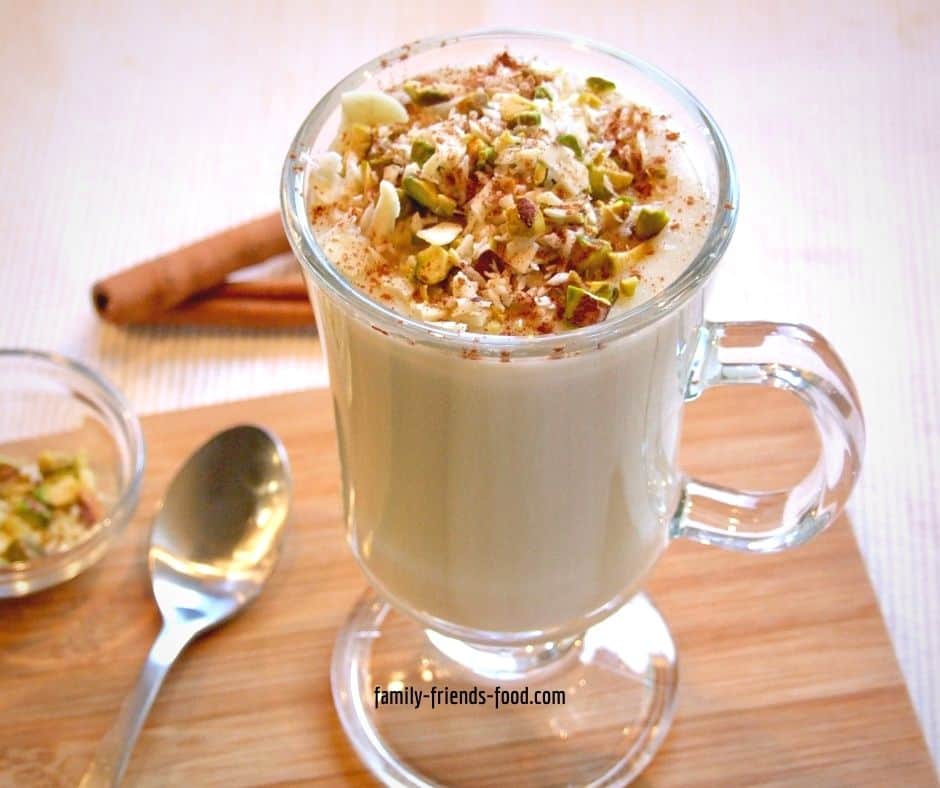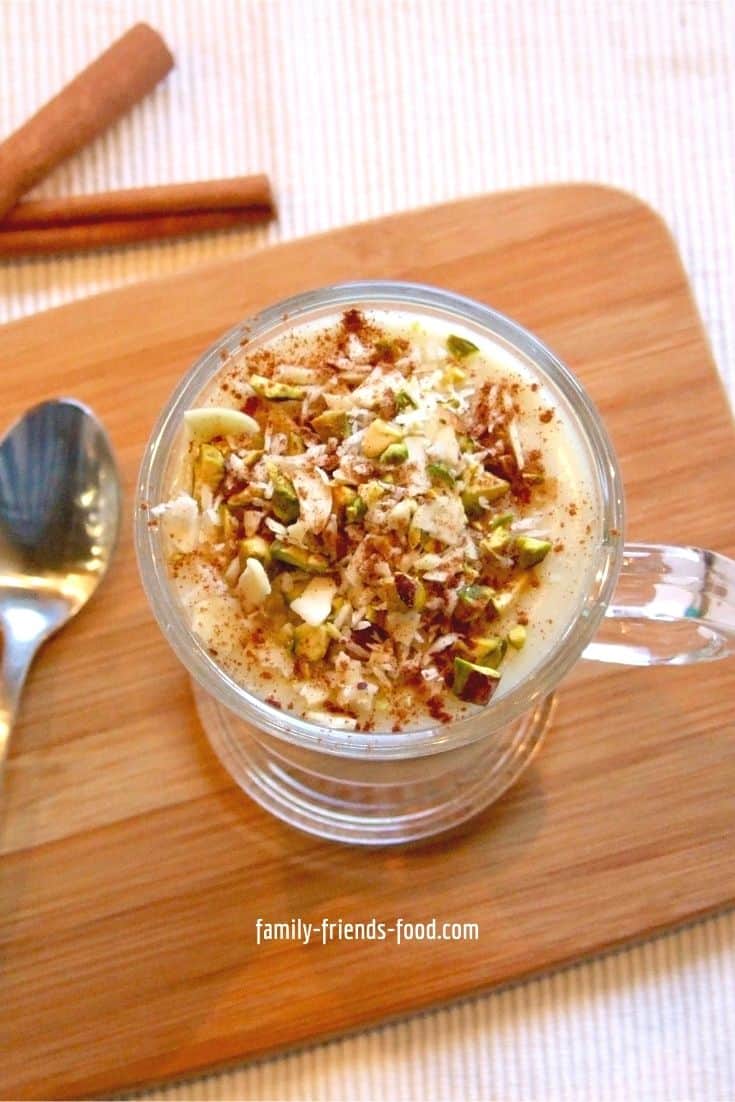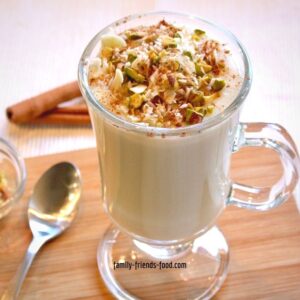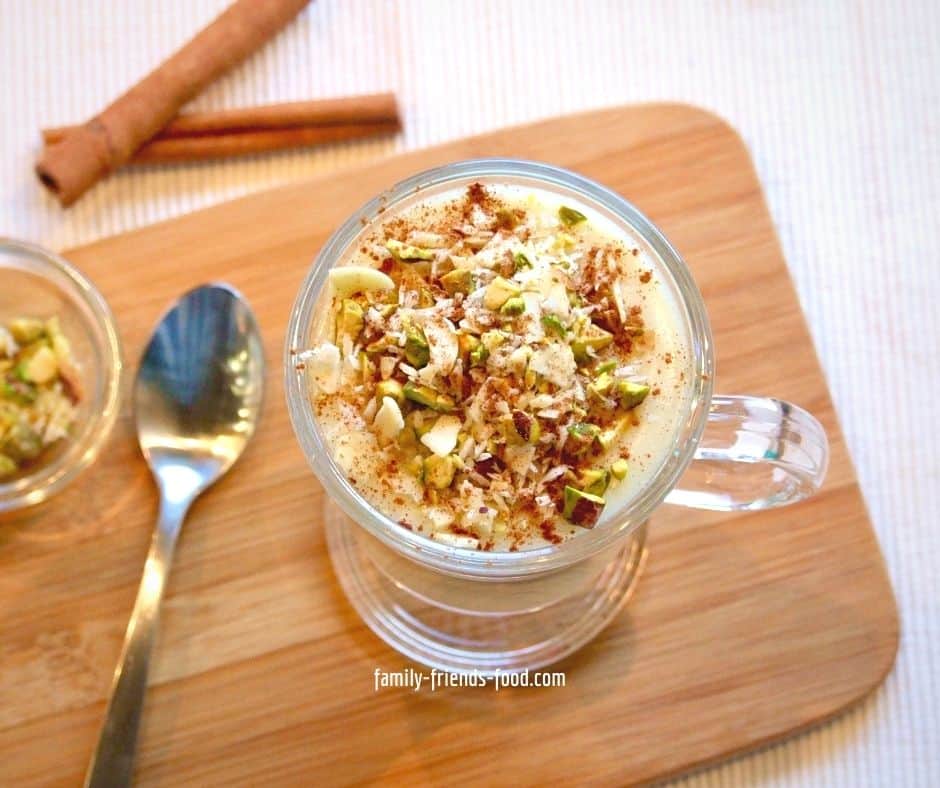Sahlab is rich, creamy and delicious, and topped with nuts and cinnamon. This traditional hot drink is a luxurious cold weather treat in Israel and across the Middle East.
I was 18 years old before I visited Israel in the winter for the first time. Despite having lots of cousins, aunts, uncles and friends there, all my previous visits had been during the hot summer months, so delicious seasonal winter specialities like sahlab had totally passed me by.

Say it with orchids…
Also known as salep, Sahlab is a thick, fragrant, milky drink, that was developed from ground orchid tubers by the ancient Greeks and Romans. It subsequently gained popularity across the countries of the Ottoman Empire, including the area which is now the State of Israel.
Authentic sahlab is made from the tubers of two European orchid species – Orchis militaris and Orchis mascula. They contain a starchy polysaccharide called glucomannan which gives sahlab its distinctive thick and smooth texture.

Sahlab – a winter speciality
People across the Middle East still eagerly consume sahlab. In Israel colourful street vendors pop up in the winter months selling it in takeaway cups from huge urns. It comes topped with nuts and cinnamon and is utterly delicious.
In recent years, boutique coffee shops have also started to sell sahlab. Sometimes there are different versions, with unusual toppings or additions like white chocolate, rose petals or chilli.

Through thick and thin
Although you can buy it everywhere from Turkey to Egypt, Jordan and beyond, the thickness of the sahlab seems to vary by region. In some countries it is allowed to cool and set completely, and is served as a pudding. In other places, it is thinner and more drinkable. The Israeli version seems to be somewhere in the middle. Just about slurpable but also thick enough for spooning.

More popular than tea?!
According to Gil Marks, writing in The Encyclopedia of Jewish Food, “In the seventeenth century, England and Germany adapted the orchid beverage… pronouncing the name saloop. Around the same time, two other foreign hot beverages appeared in Europe, coffee and tea. All three soon had their advocates, with saloop initially becoming the most widespread in England… During the nineteenth century, as coffee and tea emerged as inexpensive everyday fare, the popularity of saloop in Europe and America faded.”

Sahlab – a medical marvel!
Myths and legends around the medical properties of salep/sahlab abound. Traditionally, the drink is made from orchid roots, which are said to resemble male genitalia (orchis is Greek for ‘testicle’). As such, the plant and its derivatives allegedly have aphrodisiac qualities.
Medieval Jewish philosopher Maimonides (the Rambam) wrote that sahlab could be used to, “strengthen respiration, to revive the spirits, to arouse sexual desire…” and more which I won’t go into here! (See Practical Materia Medica of the Medieval Eastern Mediterranean According to the Cairo Genizah by Efrayim Lev and Zohar ʿAmar if you want to know more.)
Just add milk
Perhaps it’s just as well that it’s now more usual to thicken sahlab using cornflour than ground orchids, and the light, floral flavour is provided by vanilla and rose water. In Israel you can buy ‘instant’ sahlab – just add milk! – but here in the UK you need a little more creativity if you want to enjoy a cup of this wonderful drink.
Fortunately, even making sahlab from scratch is not too difficult, and it has the advantage that you can ‘season to taste’ – I find the instant stuff is often too overpoweringly flowery. Traditionally sahlab is quite heavily sweetened, but making it yourself also means you can adjust the sugar to taste. I put a tablespoon of sugar in one cup, which seems a lot but is probably less than the average!
Lower sugar sahlab
If you’re concerned about your sugar intake, you could probably swap out the sugar for an alternative sweetener. I haven’t tried it but I imagine erythritol or stevia-based sweeteners would both be fine in this sahlab recipe.

What goes on top of sahlab?
My topping here is the traditional coconut, pistachio, almond mixture plus a little ground cinnamon. However, I’ve also added cocoa nibs to this before, which is fabulous. And you sometimes also get raisins and dried fruit. Be as creative as you like!
Sahlab makes a lovely change from hot chocolate on a cold winter’s day. Why not treat your loved one (or yourself!) to a cup?

Want deliciously easy, family-friendly recipes like this one delivered straight to your inbox? Click here to sign up. (Of course, I’ll never pass on your email address to anyone.)
📖 Recipe

Sahlab
Ingredients
- 250 ml milk or non-dairy alternative
- 1 tablespoon cornflour (cornstarch)
- 1 tablespoon sugar
- ¼ teaspoon rose water
- 1-2 drops vanilla extract
Topping
- 1 teaspoon desiccated coconut
- 1 teaspoon chopped shelled pistachios
- 1 teaspoon flaked or chopped almonds
- Cinnamon to sprinkle
Instructions
- Place most of the milk in a small saucepan and heat over a low-medium flame. Reserve 2-3 tablespoon of the milk.
- Mix the cornflour, sugar, rose water and vanilla with the reserved milk, and stir well to combine.
- When the milk is nearly boiling, pour over the cornflour mixture, whisking as you do. Return the liquid to the pan, and heat, whisking constantly, until it comes to a boil.
- Continue to whisk as the liquid simmers gently for 1-2 minutes. It should be quite thick.
- Pour into a cup. Mix the coconut, pistachios and almonds together and spoon onto the top of the liquid. Sprinkle over the cinnamon and serve.
Notes
Nutrition
More delicious drink recipes
If you like Israeli drinks, try cafe hafuch – upside down coffee, or limonana – refreshing mint lemonade. Or how about a warming cup of spiced hot chocolate with hawaij l’cafe.
You might also enjoy sahlab’s cool dessert cousin – malabi. This rosewater-flavoured set pudding is delicious! Serve it topped with a luscious syrup and pomegranate seeds.
I’m linking up to a few foodie challenges. Treat Petite, hosted this month by United Cakedom on the theme ‘Like it, Love it, Gotta Have it!’ which is basically how I feel about this sahlab! I’m hoping that even though it isn’t a bake, it’s a single serve pudding/drink, so that should count, right? (Treat Petite is organised by Cakeyboi and The Baking Explorer)
This post was updated on 7/2/2022. It was originally published in February 2016.







Ted
It is very misleading to refer to Sahlab as an Israeli drink. Sahlab itself is an Arabic word for the orchid root. The root is used in several other Arabic and Turkish applications besides the beverage, such as Syrian stretchy ice cream (booza) or Turkish ice cream (dondurma). I’m surprised you don’t even mention the ubiquitousness of this beverage throughout the Arab world. Please give credit where credit is due, instead of calling this Israeli … This is how cultural appropriation occurs.
Helen
Hi Ted. In the second sentence of this article, I’ve written “This traditional hot drink is a luxurious cold weather treat in Israel and across the Middle East.”
I then go into the history and origins, including how it was spread throughout the former Ottoman empire by the Turks. Also from the article – “you can buy it everywhere from Turkey to Egypt, Jordan and beyond”. Did you even read what I’d written? Your comment suggests not.
Sahlab, in it’s Israeli incarnation, is an Israeli drink. Just as the Jordanians enjoy Jordanian sahlab, the Egyptians drink Egyptian sahlab etc. Are they ALL culturally appropriating the Turks?
Or do you maybe have some other agenda when you suggest cultural appropriation….?
Liza Rosenberg
Sahlab is, indeed, amazing and it can certainly be found all over Israel, however, it’s definitely not an Israeli drink as you indicate in your title. Its origins are in Turkey, and if anything, it’s a Middle Eastern drink that can be found in countries across the region. It’s culturally insensitive to call it an Israeli drink – and I say that as an Israeli who loves sahlab. I realize this post isn’t new, but you might want to reconsider the title.
Helen
Hi Liza. Thanks for your comment. I’m sorry you found my title insensitive, however I do think that Sahlab is an Israeli drink – at least in this particular form. As I explain in the article, sahlab originates in Turkey and has spread across the region, with different places adapting it and serving it in different ways. I would have no problem with someone else writing an article calling it “an Egyptian hot drink” or “a Jordanian milk pudding”, and in fact articles like these examples do exist. One of the things I love about food is that it has no borders, and can be endlessly adapted and evolved by people in different regions. So, I hope we can agree to disagree about the title. But I’m glad you love sahlab!
Natalie
Wow, sounds so exotic and interesting. I will definitely make this for my husband for our date night. Loe added rose water. Lovely recipe.
Helen
Ooh, it’s a perfect date night treat! Very romantic 🙂
Emily Flint
That drink was so amazing and just as described. I wonder if I could add a little espresso in the morning? Either way, I’m definitely making this again!
Helen
Oooh, a caffeinated version! Let me know if you try it….
Toni
This is such an interesting drink! And when I tried it, it didn’t disappoint! So good!
Helen
Thanks Toni. Agree, it’s really delicious 🙂
Jessica Stroup
This was so good! It was a new one for me, but a definite do again! Loved it!
Helen
Thanks Jessica, that’s so great to hear. Glad you enjoyed it!
Danielle
This sounds just incredible! I love anything made with rose water and the touch of vanilla is perfect.
Helen
Thanks Danielle. If you love rose water then you’ll definitely love this! It’s such a treat on a cold day.
Erika
This sounds delicious. I’ve never used rose water before, but it sounds so good! This is perfect for Valentine’s Day!
Helen
Thanks Erika. You should definitely try rose water. Just be careful to only add a very little at first, as the flavour can be quite strong. I hope you enjoy it!
Kathryn
The ingredients in this drink sound like they go perfectly together, especially the rose water!!
Helen
Thanks Kathryn! They are a delicious combination 🙂
Toni
Such a perfect drink for Valentine’s Day! Thanks for this easy recipe!
Helen
Thanks Toni. Happy Valentine’s Day!
Jen
We love trying new things and this looks to have jumped to the top of the list. Sounds like a great idea for Valentine’s day.
Helen
Thanks Jen! It’s super easy and very delicious so I’m sure you’ll enjoy it.
Natalie
Wow, rose water?! That sounds soooo romantic and delicious. I can’t wait to make this for Valentine’s Day. Thanks for the idea!
Helen
Thanks Natalie. Valentine’s day sounds like the perfect time to enjoy this!
Lisa
This sounds interesting! Having never heard of it before until I read your post I was like what could this be? I would like to try a cup! Thank you for sharing with this month’s Treat Petite!!
Crystal Escobar
This menu is so cute, you’re making me want to make this.
Hayley (@SnapHappyBakes)
I’d love to try this, I’m a hot chocolate addict so this could be right up my street 🙂 Thanks for linking it to #CookBlogShare
Helen
Thanks Hayley. It’s really yummy and does make a nice change from hot chocolate every once in a while.
Laura
I love how this uses pretty simple ingredients to make something that tastes fantastic – I think it’s the mark of a great recipe! Milk and I don’t always get on too well, but I think I’m willing to risk it to try this, it sounds deliciously comforting on a cold, wet, winter’s evening!
Helen
Thanks Laura. I’m also not huge friends with milk – I usually make this with oat milk but you could probably use any neutral flavoured substitute.
the foodie couple
that looks so comforting. love you blog for discovering new things 🙂
Helen
Thanks so much! That makes me really happy to hear 😀
jaklien
I think I have had this before at a Syrian place. Or at least something similar.
jaklien
And it was yummy. Forgot to say that!! 🙂
Ramya Menon @ War and Cheese
This looks lovely! I love that it uses such readily available ingredients. And it’s aphrodisiac properties sound VERY exciting! Haha
Helen
LOL! I think you’d have to track down the orchid powder to get the full effect – good luck!
MAI SABOUR
I’m sorry but how is this a Israeli cuisine? This drink is very popular in Turkey and Egypt. A very local and popular drink in Egypt. Hope you set the records straight.
Helen
Hi Mai. Thanks for your comment. As I outlined above, this drink is popular across the Middle East. It originates in Turkey and is enjoyed in Egypt, Israel, Jordan and many other places. Often, each location has their own regional variations. This is my recipe for the Israeli version of this drink. I think it’s great that diverse people across the region all enjoy this delicious beverage!
Platter Talk
What a decadent and refreshing treat you have created here; I’m getting a big mug out this very minute….
Helen
Thanks! Enjoy 😀
Kitty Kaos (@kellykaos)
Oh this looks amazing I am such a foodie and so is the bf so we may give this one a go x
Miss Kitty Kaos – Adventures Of A Riot Grrrl
Helen
Thanks Kitty! I hope you both enjoy it <3
watchlearneat
I’ve never had sahlab before, but it looks delicious! I enjoyed reading the history of the drink too!
Helen
Thanks! I always like to find out the background to things like this.
Victoria
Wow this looks awesome! Thanks!
April @ Girl Gone Gourmet
So fun to learn something new – I’d never heard of this drink! Sounds so warm and cozy for a cold day.
choclette
Oh what fun. This drink has completely passed me by, despite spending the 6 winter months in Egypt. Love the idea of ground orchids, though I always thought they were poisonous. I think I might just have to go and make myself a cup now, although the sugar bit might have to be severely curtailed.
Helen
I think it depends on the orchid, Choclette. I hope you enjoy it, anyway, even without the requisite ton of sugar!
One Two Culinary Stew
Wow! That looks deliciously comforting and filling.
Helen
Thanks! Comforting is the word – like a cuddle in a mug, with cinnamon on top 🙂